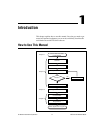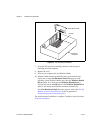Chapter 1 Introduction
© National Instruments Corporation 1-3 PCI Serial for Windows Me/9x
Additionally, the PCI serial boards are available in a two-port version
(PCI-232/2 and PCI-485/2), a four-port version (PCI-232/4 and
PCI-485/4), an eight-port version (PCI-232/8 and PCI-485/8), and a
sixteen-port version (PCI-232/16). The two-port versions use DB-9
connectors. The four-port versions use 10-position modular jacks to
provide all four connections on a single back panel. Optional cable
accessories convert the 10-position modular jacks to either DB-9 or DB-25
connectors with standard pinouts. The eight-port versions use adapter
cables to convert the 68-pin connector on the board to eight DB-9
connectors. The sixteen-port version uses a breakout box to convert the
100-pin connector on the board to sixteen DB-9 connectors. Throughout
this manual, PCI serial boards refers to all versions of the PCI serial
boards.
The isolated PCI-232 and PCI-485 boards are designed for applications in
harsh environments. Isolated ports provide reliable communication in
situations involving ground loops from different ground levels or high
common mode voltage induced on the lines in noisy environments.
Non-isolated ports may not provide reliable communication in those
situations. The isolation between each communication port and the host PC
ensures the safe operation of the PC and the devices connected to other
ports on the same board, in case of accidental high voltages on
communication lines.
The PCI-485 boards support four hardware transceiver control modes
for reliable communication with two- and four-wire devices. For more
information about transceiver control modes, refer to Chapter 4, Using
Your Serial Hardware.
All serial hardware uses standard 16550-compatible UARTs (Universal
Asynchronous Receiver/Transmitters) for complete compatibility
with standard PC COM ports. The serial hardware contains FIFOs
(First-In-First-Out) buffers to reduce susceptibility to interrupt latency
for faster transmission rates. Full Plug and Play compatibility allows
switchless configuration and installation. For more information about
the serial hardware specifications and operating conditions, refer to
Appendix D, Specifications.


















